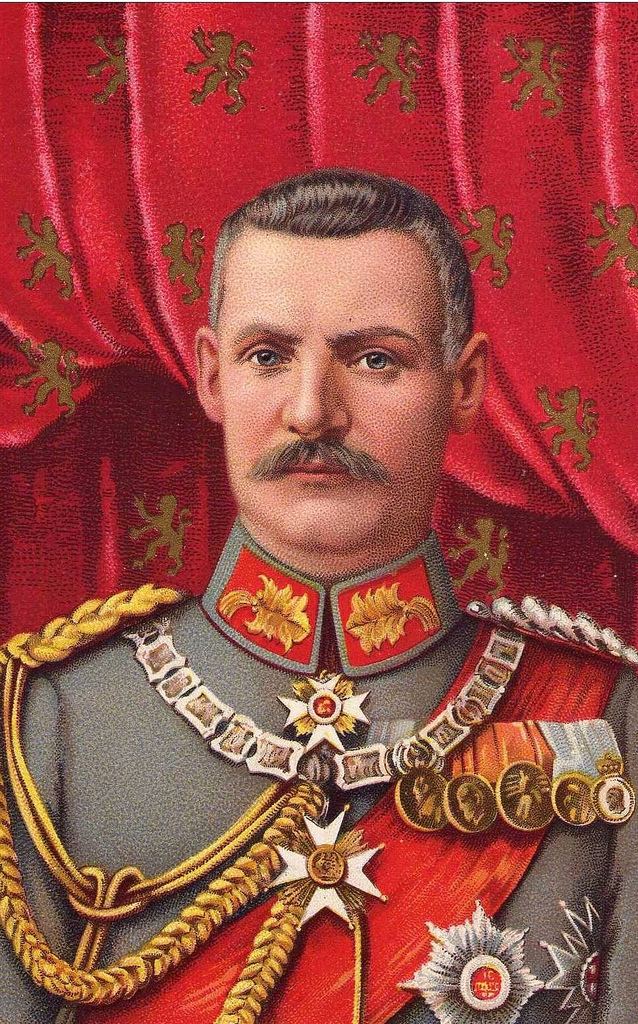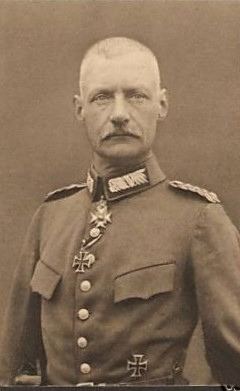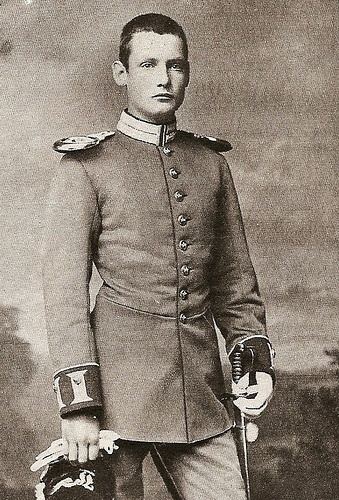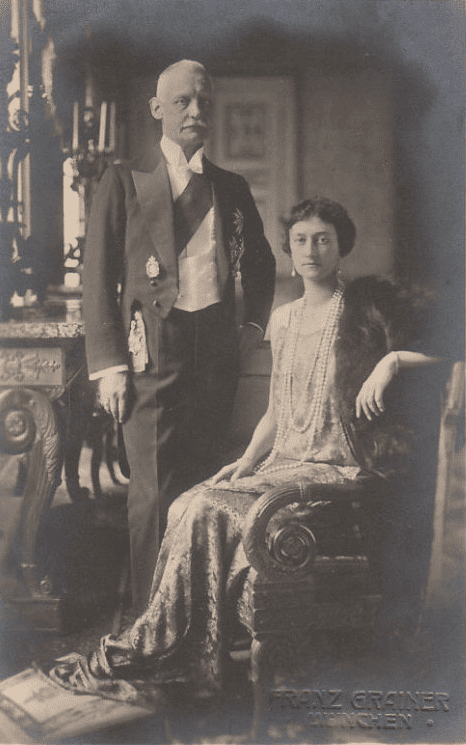House Wittelsbach Father King Ludwig III | Name Rupprecht, Prince Role Military Commander | |
 | ||
Born 18 May 1869
Munich, Kingdom of Bavaria ( 1869-05-18 ) Burial Theatine Church, Munich Issue Luitpold, Hereditary Prince of Bavaria
Princess Irmingard
Albrecht, Duke of Bavaria
Prince Rudolf
Prince Heinrich
Irmingard, Princess Ludwig of Bavaria
Princess Editha, Mrs. Schmert
Princess Hildegard, Mrs. de Loayza
Princess Gabrielle, Duchess of Croy
Princess Sophie, Duchess of Arenberg Mother Archduchess Maria Theresia of Austria-Este Died August 2, 1955, Starnberg, Germany Spouse Princess Antonia of Luxembourg (m. 1921), Duchess Marie Gabrielle in Bavaria (m. 1900) Children Albrecht, Duke of Bavaria, Princess Irmingard of Bavaria, Prince Heinrich of Bavaria Parents Maria Theresa of Austria-Este, Ludwig III of Bavaria Grandchildren Franz, Duke of Bavaria, Prince Luitpold of Bavaria, Prince Max, Duke in Bavaria Similar People Ludwig III of Bavaria, Princess Antonia of Luxembourg, Franz - Duke of Bavaria, Prince Luitpold of Bavaria, Maria Theresa of Austria‑Este | ||
Rupprecht or Rupert (18 May 1869 – 2 August 1955) was the last Bavarian crown prince. During the first half of the First World War he commanded the German Sixth Army on the Western front. From August 1916 he commanded Army Group Rupprecht of Bavaria, which occupied the sector of the front opposite the British Expeditionary Force.
Contents
- Childhood
- Pre First World War
- First World War
- Links to military aviation
- Interwar years
- Second World War
- Post war
- Death
- Children
- Styles
- Decorations and honors
- Military ranks
- Works
- References

Childhood

Rupprecht was born in Munich, the eldest of the thirteen children of Ludwig III, the last King of Bavaria, and of Archduchess Maria Theresa of Austria-Este, a niece of Duke Francis V of Modena. He was a member of the lineage of both Louis XIV of France and William the Conqueror. As a direct descendant of Henrietta of England, daughter of Charles I of England, he was claimant to the thrones of England, Scotland and Ireland in the Jacobite succession as Rupert. His early education from the age of seven was conducted by Freiherr Rolf Kreusser, an Anglo-Bavarian. In his youth, he spent much of his time at Schloss Leutstetten, Starnberg, and at the family's villa near Lindau, Lake Constance, where he was able to develop a keen interest in sports. His education was traditional and conservative, but he became the first member of the royal house of Bavaria to spend time at a public school, when he was educated at the Maximilian-Gymnasium in Munich, where he spent four years. Apart from his academic studies and his training in riding and dancing, at school he was also obliged to learn a trade, and his choice fell on carpentry.
Pre-First World War
Rupprecht's grandfather, Luitpold, became de facto ruler of Bavaria when King Ludwig II and his successor Otto both were declared insane in 1886. Rupprecht's own position changed somewhat through these events as it became clear that he was likely to succeed to the Bavarian throne one day.

After graduating from high school, he entered Bavarian Army's Infanterie-Leibregiment as a Second Lieutenant. He interrupted his military career to study at the universities of Munich and Berlin from 1889 to 1891. He rose to the rank of a Colonel and became the commanding officer of the 2nd Infanterie Regiment Kronprinz but found enough opportunity to travel extensively to the Middle East, India, Japan and China. His early journeys were made with his Adjutant, Otto von Stetten. Later he was accompanied by his first wife.

At the age of 31, Rupprecht married his kinswoman Duchess Marie Gabrielle in Bavaria, with whom he had five children before her early death in 1912 at the age of 34.
In 1900 he became the 1,128th Knight of the Order of the Golden Fleece in Austria.
In 1906, Rupprecht was made commander of the Bavarian I Army Corps, with the rank of lieutenant general of the infantry, promoted to full general in 1913.
In 1912, Luitpold was succeeded in the position of Prinzregent by his son Ludwig. On 5 November 1913, Ludwig was made king by vote of the Bavarian Senate, becoming Ludwig III. This decision also made Rupprecht the crown prince of Bavaria.
First World War
He commanded the German Sixth Army at the outbreak of World War I in Lorraine. While part of the German army was participating in the Schlieffen plan, the Crown Prince led his troops on to the Battle of Lorraine. The appointment to command of the Sixth Army was as a result of his royalty, but the level of study he had performed before he took command was a factor behind his successful direction of the Sixth Army, and he proved to be a highly able commander. Rupprecht's army gave way to the French attack in August 1914, in the Battle of Lorraine, and then launched a counteroffensive on the 20th. Rupprecht failed to break through the French lines. He was later in command of the 6th Army in Northern France and remained on the Western Front during the stalemate that would last until the end of the war. Only a few days after the battle, his oldest son Luitpold died of polio in Munich.
During the spring of 1915, Rupprecht sent an answer to von Bissing, the Governor-General of Belgium, on the latter's inquiry about Bavaria's opinion on the "Belgian question". Rupprecht envisaged an economic and military association of Belgium with Germany by introducing the Netherlands, enlarged by the Flemish areas of Belgium and northern France, and Luxembourg, enlarged by Belgian Luxembourg, as new federal states of the German Empire. To the Kingdom of Prussia Rupprecht suggested other areas of northern France, Walloon Belgium with Liege and Namur, and the salient of the Netherlands round Maastricht. The Imperial Territory of Alsace-Lorraine and the rest of Lorraine was to be partitioned between Bavaria and Prussia. Rupprecht's goal was to reduce Prussia's hegemonic role in the Reich by building a sort of an imperial triumvirate of power between Prussia, Bavaria and the Netherlands.
Rupprecht achieved the rank of field marshal (Generalfeldmarschall) in July 1916 and assumed command of Army Group Rupprecht on 28 August that year, consisting of the 1st, 2nd, 6th and 7th armies. Rupprecht has been considered by some to be one of the best Royal commanders in the Imperial German Army of World War I, possibly even the only one to deserve his command. Rupprecht came to the conclusion much earlier than most other German generals (towards the end of 1917), that the war could not be won, seeing an ever increasing material advantage of the allies. He also opposed the "scorched earth" policy during withdrawals, but his royal position made a resignation on those grounds impossible for him, even though he threatened it. He eventually resigned from his command on 11 November 1918.
He became engaged to the much younger Princess Antoinette of Luxembourg in 1918, but Germany's capitulation delayed their marriage and the engagement was canceled again.
Links to military aviation
Max Immelmann, one of the most famous German First World War Flying Aces, referred in a letter written on 25 June 1915 to a visit by Rupprecht to an airfield to inspect the new Fokker Eindecker aircraft.
Primarily to see these fighting machines, yesterday the Crown Prince of Bavaria visited the field and inspected us and Abteilung 20. Director Fokker, the constructor of the combat aircraft, was presented to him.
Interwar years
On 12 November 1918, in the wake of civil unrest in the last days of the war, Rupprecht's father, Ludwig III, promulgated the Anif declaration releasing his officials, officers and soldiers from their oaths. Although he did not formally abdicate (and some loyalists would continue to refer to Ludwig as King), the declaration was interpreted by the government of Bavaria as an abdication, making Bavaria a republic and ending 738 years of Wittelsbach rule; Rupprecht thus lost his chance to rule Bavaria. Rupprecht escaped to Tyrol in fear of reprisals from the brief communist regime in Bavaria under Kurt Eisner but returned in September 1919. While away from Bavaria, he succeeded his mother, Maria Theresia of Austria-Este, the last Queen of Bavaria, as the Jacobite heir. This occurred upon her death on 3 February 1919. As such, under his anglicized name he would be King Robert (or Rupert) (King of England) and IV (King of Scotland), although he never claimed these crowns and "strongly discouraged" anyone from claiming them on his behalf. He was styled "Duke of Cornwall and Rothesay" because of his mother's claim.
The changed political situation however allowed him finally to marry Princess Antoinette of Luxembourg on 7 April 1921. The ceremony was carried out by the nuncio to Bavaria, Eugenio Pacelli, later Pope Pius XII.
Shortly after the 1922 Washington Naval Conference, he made a statement regarding the possible ban of aerial bombing, poison gas, sea blockades and long range guns, blaming them for a majority of civilian casualties during the last war. He also advocated Germany's participation in future peace conferences, and he dismissed claims that Kaiser Wilhelm II was to blame for the First World War.
While opposed to the Weimar Republic and never having renounced his rights to the throne, Rupprecht envisioned a constitutional monarchy for Bavaria. Upon his father's death in October 1921, Rupprecht declared his claim to the throne since his father had never formally renounced his crown in the Anif declaration. While never crowned king, he did become the head of the House of Wittelsbach after his father's death. He formed the Wittelsbacher Ausgleichfond in 1923, which was an agreement with the state of Bavaria leaving the most important of the Wittelsbach palaces, like Neuschwanstein and Linderhof, to the Bavarian people.
Rupprecht was never enticed to join the far right in Germany, despite Hitler's attempts to win him over through Ernst Röhm and promises of royal restoration. He helped persuade Gustav von Kahr to not support Hitler during the Beer Hall Putsch. Hitler confided in private to a personal dislike of the Crown Prince. The Crown Prince in turn confessed to King George V at a lunch in London in the summer of 1934 that he considered Hitler to be insane.
With the worsening of the Great Depression in 1932, a plan was floated to give Rupprecht dictatorial powers in Bavaria under the title of Staatskommissar. The plan attracted support from a wide coalition of parties, including the SPD and the post-war Bavarian Minister-President (First Minister) Wilhelm Hoegner but the legal appointment of Hitler as Reichskanzler in 1933 by Hindenburg and the hesitant Bavarian government under Heinrich Held ended all hopes for the idea.
Rupprecht continued to believe that restoration of the monarchy was possible, an opinion he voiced to the British ambassador Eric Phipps in 1935.
It was at this time that H.G. Wells wrote his vision of future history, The Shape of Things to Come, in which a "Prince Manfred of Bavaria" in the later part of the 20th century was depicted as the leader of a widespread rebellion against the rise of a world government and its unification of the world. Presumably, Wells envisioned that "Prince Manfred" to be a descendant of Prince Rupprecht and an heir to Rupprecht's ambitions.
Second World War
Rupprecht was forced into exile in Italy in December 1939 (the last straw being the confiscation of Schloß Leutstetten by the Nazis) where he stayed as a guest of King Victor Emmanuel, residing mostly in Florence. He and his family were barred from returning to Germany. He continued to harbor the idea of the restoration of the Bavarian monarchy, in a possible union with Austria as an independent Southern Germany. In a memorandum in May 1943, he voiced his opinion that Germany would be completely defeated in the war and hoped to spare the German people from the worst when the Nazi regime finally fell. He even mentioned his ambition for the German crown, which had been held by the House of Wittelsbach in the past.
In October 1944, when Germany occupied Hungary, Rupprecht's wife and children were captured, while he, still in Italy, evaded arrest. They were first imprisoned in the Sachsenhausen concentration camp at Oranienburg, Brandenburg. In April 1945 they were moved to the Dachau concentration camp, where they were liberated by the United States Army. Crown Princess Antoinette never recovered completely from the captivity, and died in 1954 in Switzerland, having vowed never to return to Germany after her ordeal. She was buried in Rome but her heart was, complying with Wittelsbach tradition, enshrined in the Gnadenkapelle (Chapel of the Miraculous Image) at Altötting.
Towards the end of the war, a US Army officer, Col. Albert Caswell Metts, Jr., assisted Rupprecht's five daughters in returning to Luxembourg. On May 16 he drove them to Schloss Hohenschwangau, then to Schloss Berg, and then to Schloss Leutstetten. Late at night they knocked on the door of the Samerhof, a house owned by the Royal Family across the street from the castle. At the door of the Samerhof the princesses were met by their uncle Franz with his sons Ludwig and Rasso; they had managed to escape from Hungary and to bring with them some of the royal family's famous Sárvár horses. Later the princesses were driven to Augsburg from where they flew to Luxembourg.
Post war
Rupprecht continued to advocate the restoration of the Bavarian monarchy upon his return but found no support from the US occupation authorities who, however, treated him courteously. General Dwight D. Eisenhower provided a special plane to fly him back to Munich in September 1945 and he returned to Schloss Leutstetten.
It is estimated that he had the support of 60 to 70% of the Bavarian population in his goal to restore the monarchy in the post-war years. Of the 170 members of the Bavarian parliament, 70 declared themselves to be monarchists in September 1954, a clear sign of support for the Crown Prince.
Death
Upon his death in 1955 at Schloss Leutstetten at the age of 86, he was treated like a deceased monarch, receiving a state funeral. His life had spanned the independent Kingdom of Bavaria, the German Empire, the Weimar Republic, Nazi Germany, Allied-occupied Germany, and the establishment of West Germany. He is buried in the crypt of the Theatinerkirche in Munich near his grandfather Prince Luitpold and great-great-grandfather King Maximilian I, between his first wife Duchess Maria Gabrielle and his oldest son Prince Luitpold.
Children
Rupprecht married twice and had a total of eleven children:
Styles
His full title was His Royal Highness Rupprecht Maria Luitpold Ferdinand, Crown Prince of Bavaria, Duke of Bavaria, of Franconia and in Swabia, Count Palatine of the Rhine.
Decorations and honors
Among others, Rupprecht received the following Medals and Orders:
Kingdom of Bavaria
Kingdom of Prussia
Other German states
Other countries
